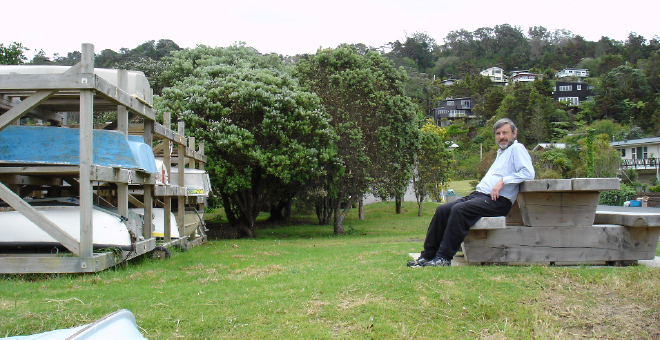Ōpahi four for the chop, or the battle for Mont’s trees
Some twelve years ago, when he was enjoying much better health, Professor Sir Graham (Mont) Liggins motivated local residents to plant pōhutukawa and tōtara near the beach at the end of Ōpahi Bay Road, on the road reserve.

Protector of a Pleasant Place: Before five of the trees that John Timmins and neighbours establised are felled, to squeeze in possibly no more than one extra vehicle, John ‘suggests’ that options for the area first be discussed by the community. photographer Cimino Cole
The area, with its now well established trees, a substantial macrocarpa picnic table, timber dinghy rack and tastefully designed toilets (composting) is a pleasant oasis compared to the dusty, barren wasteland that was, when dominated by rusty steel bins overflowing with refuse and sun-ripened fish remains.
During the many rich years the Kewene family was resident, the entrance to their property was there. (Bill, whose Māori pronunciation was impeccable, and his voice like velvet, always insisted it was Ōpahi; no Bay.) Subsequent owners gained privacy by relocating the driveway to the opposite end of the property and the opportunity was presented to Mont Liggins, and a then functional Mahurangi West residents and ratepayers association, to create at least the illusion of a foreshore reserve.
In 1962, when surveyor Ron Buckton designed the subdivision of Bill Kewene’s land, provision for esplanade reserves had only recently been provided for. Consequently, the Kewene and Mahon establishments, right on the beach front, were designed around, which left only scant strips of terra firma between them and the tide.
Ironically, the Jamieson Bay subdivision completed three years earlier, for all its flaws, did a better job of creating esplanade reserve. But even there it was compromised by existing use. The original Govan Jamieson homestead was extant and the plan view of the esplanade shows how the reserve narrows in concession to the, by then long-abandoned, house—haunted, according to local school children. Even before the ink was dry on the subdivision plan, the old place was demolished leaving the ghost of the homestead and a compromised reserve—highlighted currently as the community-built seawall crumbles.
On Friday morning while making a cup of coffee in the house that has replaced that of the indomitable Gordon Mahon, the similarly indomitable John Timmins was surprised to see a group of men passing sentence on a number of Mont’s pōhutukawa. While there were no chainsaws in evidence, defence attorney Timmins wasted no time in introducing himself and demanded an explanation of what was proposed for these trees, directly in the view of his kitchen and lounge. ‘How will this affect you?’ John was asked.
Well, I look at them!—from just there!
John was advised, to the effect that he would have to get used to not looking at them, as the space was needed for parking—consultation had been undertaken.
Not with me, you haven’t!
John was told he could have his say by phoning Rodney District Council, which he later attempted to do, only to be referred him back to the contractor with whom he had been ‘consulting’ at Ōpahi. The contractor insisted that the work would proceed regardless of consultation, and before Christmas. This position changed only after the contractor appreciated that a High Court proceeding would precede the proclaimed tree felling. Thanks to John Timmins affecting a stay of proceedings—and it was a promise, not a threat, to injunct Rodney District Council and Works Infrastructure Limited if consultation was denied—meaningful consultation can now commence.
The requirement to consult should, by now, be second nature. And John Timmins just happens to be an expert on the legal requirement to consult. He recently provided the Mahurangi Breakfast Club with a ten-point summary to assist the community discussions that are commencing regarding the future of the Mahurangi Action Plan. There are countless examples of where the local communities, who have all the collective time in the world to work through the myriad permutations, can save their local council from going off half-cocked and wasting those painfully extracted rates. The diabolically expensive and patently unsatisfactory Ngārewa Drive intersection is just one example.
Parking is an issue at Ōpahi, but the area is finite—only so many vehicles can be accommodated on the road reserve at the bottom of the hill. The community, and visitors, may well consider Ōpahi deserves better that to be totally given over to boat-trailer parking.
